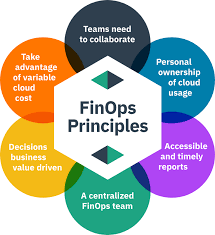The public cloud has unlocked unprecedented velocity and scale for software teams. However, as complexity grows exponentially, so do infrastructure costs. DevOps leaders balancing feature rollout with budget find themselves scrutinized from both sides.
On one hand, developers need more resources to build faster. On the other, finance raises concerns over surprising cloud overages. Lost somewhere in between sit optimization opportunities obscured by lacking visibility.
With infrastructure as code and CI/CD automation maturing, what’s still missing is financial rigor applied to cloud operations. Enter FinOps.
FinOps brings accountability, analytics, and automation to strategically manage variable cloud consumption. As this emerging discipline for cloud financial management permeates organizations, technology leaders are realizing FinOps skillsets now provide competitive edge.
The practice originates from the need to align cloud capacity with application demands in real-time rather than through reactive governance. By instrumenting FinOps within native developer workflows, resource allocation dynamically scales up and down based on live signals.
The result? Developers retain velocity while cloud utilization optimizes continuously to changing conditions. Features release faster on infrastructure sized sustainably to each workload.
For DevOps leaders balancing feature rollout with budgets, this is game changing. More innovation unlocks safely through increased collaboration between engineers and business finance teams.
Let’s learn more about FinOps in this special issue by Talent500:
Transforming Cloud Economics with FinOps Practices
Legacy approaches to governing cloud infrastructure break down even at modest complexity. Procurement driving contracts lack context on workload elasticity needs. Finance reviewing monthly spend struggles to decode line items across services, applications, environments, and regions.
These disconnected processes increase friction and blame between teams. Engineering moves too fast for clumsy financial oversight yet remains accountable for overspending against opaque budgets.

(Credits)
FinOps overcomes these problems by aligning technology and business units to shared data-driven processes. Granular cost analytics expose optimization opportunities while empowering developers to right-size deployments through automation.
With real-time visibility into consumption rates and spending trajectories, overprovisioned resources scale back dynamically during valleys. Additional capacity spins up seamlessly as demand spikes again.
Meanwhile, finance gains guardrails around budgets through thresholds, tagging policies, and predictive forecasting. Moving up the accountability chain, executives have transparency into margins and unit economics per product and customer.
All in all, FinOps transforms cloud waste into sustained advantage. What was once stranded capacity paid for but unused converts into resources intelligently aligned to workload needs in real-time.
Why Cloud Financial Management Requires a Cultural Shift
Instrumenting FinOps at scale depends on buy-in across the org chart to evolve behaviors, processes, and tools collectively. Since optimized cloud utilization aligns all stakeholder incentives, motivating adoption requires strategic messaging tailored to each audience.
For developers, the value proposition is straightforward – retain velocity while sustaining feature quality and availability. Frame target efficiency metrics as enablers of productivity rather than constraints. Emphasize automation liberating talent for innovation over governance.
Convince business finance partners by quantifying the hard opportunity cost of wasted cloud spend in terms of headcount, hardware, and software. Draw the line from reclaimed budget to fueling product investments and entering new markets sooner.
Get executives excited by projecting explosions in revenue and customer acquisition as increased launch cadence compounds over quarters. Support bold claims using benchmark data showing leading cloud-native startups outpacing incumbents disrupted by the pace of software innovation.
Secure grassroots enthusiasm across middle management by spotlighting engineering heroes delivering more features on less cloud budget. Celebrate automation engineers who create self-funding optimization tooling. Fuel healthy competition between peer teams on efficiency leaderboards.
Perhaps most importantly, incentivize collaboration between technology and business units. Well aligned team building trust through transparency into real-time usage, costs, and planning.
Common Pitfalls Plaguing DevOps Cloud Cost Management
Despite accessibility transforming infrastructure procurement, several issues routinely catch teams off guard:
- Overspending – With no visibility into live cost run rates, actuals far exceed budgets.
- Resource sprawl – Forgetting to shutdown idle deployments multiplies waste.
- Unexpected demand – Failing to scale capacity dynamically with traffic causes outages.
- Speed obsession – The instinct to overspend to ship features faster backfires.
- Poor forecasting – Not right-sizing resources upfront locks in preventable costs.
- Limited observability – Granular cost analytics to optimize remain obscured.
These problems boil down to DevOps lacking contextual signals into cloud consumption rates linked to the environments and applications they manage. Without real-time insight, overprovisioned capacity goes undetected while available budget drains quicker than anticipated.
Addressing the disconnect through clumsy manual oversight simply inserts delays rather than preventing surprises. If engineering moves too quickly for static governance, the cycle continues deteriorating despite best intentions on both sides.
FinOps fixes these issues at the root by exposing cost analytics natively to developers and augmenting deployments with auto-scaling. Cost efficiency transforms from afterthought to design goal.
Best Practices for Integrating FinOps into DevOps CI/CD Pipelines
To embed sober financial thinking into pipelines, DevOps should instrument automation workflows with cloud efficiency in mind:
- Visibility: Ingest granular cost data and enrich telemetry with usage analytics.
- Accountability: Set efficiency targets per workload aligned to code owners.
- Testing – Shift left by benchmarking optimal scale during builds.
- Deployments – Right-size instances and tag extensively.
- Intelligence – Layer predictive auto scaling rules tailored to each app.
- Monitoring – Scale capacity based on live application metrics.
- Decommission – Define policies to terminate unused resources.
- Collaboration – Involve FinOps teams early in planning cycles.
- Automation – Standardize policy-based optimization tooling.
When implemented as a group, these steps make considering the cost implications of infrastructure decisions a natural part of developer thinking. Feature teams retain autonomy to build, deploy, and run workloads how they choose while collaborating with FinOps experts to maximize efficiency.
What sets leading teams apart is recognizing when manual intervention becomes necessary versus when automation takes over safely. Rules preventing overallocation may initially run during business hours before relaxing overnights and weekends. Policies right-sizing production resources would remain even more constrained than those governing dev, test, and staging.
Where to Start with Lightweight FinOps Instrumentation
A hurdle DevOps leaders face when evaluating FinOps is the significant upfront effort required by most commercial platforms before providing value. Lengthy enterprise sales cycles give way to months of professional services integrating multiple data streams to unite cost management.

(Credits)
By the time dashboards materialize, the workflows they were meant to optimize may have shifted again. And configuring new reports requires more services fees or obscure debugging.
An alternative approach is starting with your own data scientists extracting basic cloud bills and enriching logs with custom usage telemetry. Simple tooling exposing visibility into granular spending linked to deployments, applications, and code owners unblocks initial efficiencies.
These savings then secure executive support for a more robust platform while allowing in-house analytics talent to validate genuine solution fit. Essentially, instrumenting lightweight FinOps MVPs early unblocks immediate value.
The steps include:
- Ingest raw cloud billing data into a lake (or warehouse).
- Parse records via scripts to generate intermediary tables.
- Map costs dynamically to custom resource tags and labels.
- Build basic visibility dashboards for developers and finance users.
- Identify quick optimization wins to showcase value.
- Layer predictive modeling as complexity increases over time.
- Eventually transition to commercial tools after extracting lessons.
This bottoms-up approach lets your FinOps practice mature gradually while delivering value incrementally. Starting small also provides runways for talent to skill up through hands-on building versus top-down mandates they inherit ownership over.
Exposing even basic visibility into cloud consumption rates linked to applications, environments, and owners allows developers to right-size overprovisioned resources immediately. More advanced analytics can wait until necessary.
Pitfalls to Avoid When Implementing FinOps
Since FinOps aims to maximize cloud value via alignment, forced implementations risk deterioration rather than improving relationships between teams:
- Strangling autonomy through rigid governance activates cultural antibodies rejecting oversight.
- Optimizing too aggressively causes performance loss, outraging internal customers.
- Chasing cost savings at the expense of innovation leaves money on the table long-term.
- Failing to incentivize cross-functional collaboration entrenches rather than breaks down silos.
- Poor data quality obscures true cost drivers, directing focus incorrectly.
- Attempting to boil the ocean burns political capital quickly on initiatives delivering limited initial value.
- Dictating manual processes when automation is possible overload teams with bureaucracy.
- Not allowing practices to evolve organically prevents sustained adoption.
Essentially, approaches which hamper developer velocity hurt feature delivery and unit economics simultaneously. They signal to technologists that FinOps teams more closely resemble “business police” rather than partners. This cripples adoption rates initially and continually.
Instead, apply FinOps thinking selectively around workflows causing the largest inefficiencies first. Celebrate quick wins through rewards reinforcing desired behaviors. Then let gravity take over as peers replicate initial success.
The Secret Ingredient – Distilling Business Impact from Cost Analytics
What sets leading FinOps implementations apart is the depth of questions answered by their cloud analytics. Simply exposing dashboards visualizing spend categorized across high-level dimensions only scratches the surface of potential value.
Sophisticated modeling reveals deeper insights into unit economics, unveiling key levers for efficiency gains:
- Granular cost per feature shaped by usage intensities exposes optimization opportunities.
- Clustering customers by infrastructure demands forecasts scaling needs.
- Comparing environments guides standards for architecting new apps.
- Evaluating experiments against budgets steers investment roadmaps.
This degree of analytical sophistication requires both aggregated billing from cloud providers and fine-grained telemetry from applications. Cleanly stitching together feeds from each reveals holistic insight difficult to achieve otherwise.
With visibility into variable unit costs per product and customer, true drivers of cloud consumption emerge. Rightsizing no longer means blanket restrictions but rather aligning resources dynamically to workload patterns.
More than Just Saving – FinOps Unlocks Innovation Velocity
For forward-looking organizations, migrating workloads to the cloud promises more than infrastructure cost savings. When paired with instrumented FinOps practices, the variable capacity consumption model becomes a lever for speed advantage over legacy IT incumbents.
Consider that even basic efforts typically deliver ~30% reductions in cloud spend by addressing overprovisioning and sprawl. Reinvesting these savings into fueling 20% gains in developer productivity compounds quarterly as new features launch faster.
Sophisticated analytics into workload patterns and customer journeys allow optimizing provisioning rules tailored to each application and user segment. As deployments dynamically size to signals like traffic, seasonal cycles, and customer growth, efficiency improves continually without manual intervention.
Over 12 months, reclaimed budget and compounding velocity accumulate into run rate lift from reinvestment. Extend the horizon to 3 years and the gap to status quo widens exponentially. Pair this scaling application portfolio with pricing power from fast iteration and network effects.
In such models, early investment into FinOps instrumentation provides the foundations and data asset moat necessary for sustainable advantage as complexity increases across quarters.
The Road Ahead- FinOps to Anchor Cloud Centers of Excellence
With public cloud consumption accelerating faster every year, managing scale will only intensify as competitive advantage concentrates among cloud leaders. Gartner forecasts that 45% of companies will overspend their cloud budget by 70% in their first 18 months of migration due to lacking visibility and controls.
In response, forward-looking organizations are preemptively upskilling technical talent into cloud centers of excellence specialized around capabilities like FinOps. They recognize mastering cloud financial management – while less exciting than building features – has become table stakes for unlocking innovation safely.
Equipping these teams with context for cost analytics and authorization over optimization decisions allows the broader technology org to focus aggressively on shipping. By partnering with infrastructure coaches to architect within guardrails, product teams retain autonomy without surprises.
Far beyond an exercise in balancing books, instrumenting FinOps ultimately enables product and technology orgs to find natural alignments. Developers retain velocity while finance provides insight into usage intensities shaping unit economics. Together both partners accelerate responsibly.
Are you a seasoned DevOps leader looking for a new challenge?
Sign up on Talent500 and browse through high TC jobs with good benefits and PTO.






Add comment